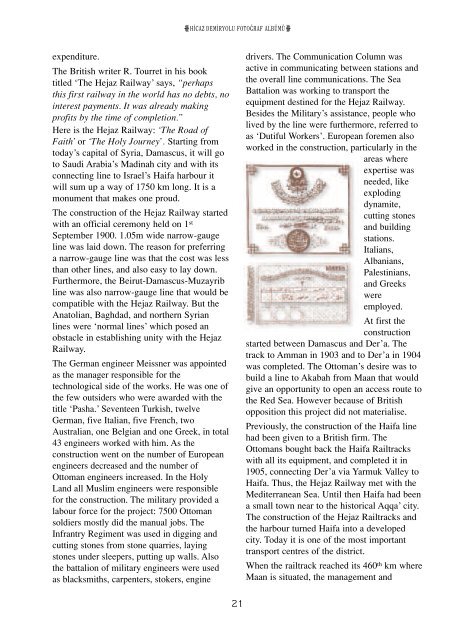Create successful ePaper yourself
Turn your PDF publications into a flip-book with our unique Google optimized e-Paper software.
X H‹CAZ DEM‹RYOLU FOTO⁄RAF ALBÜMÜ C<br />
expenditure.<br />
The British writer R. Tourret in his book<br />
titled ‘The Hejaz Railway’ says, “perhaps<br />
this first railway in the world has no debts, no<br />
interest payments. It was already making<br />
profits by the time of completion.”<br />
Here is the Hejaz Railway: ‘The Road of<br />
Faith’ or ‘The Holy Journey’. Starting from<br />
today’s capital of Syria, Damascus, it will go<br />
to Saudi Arabia’s Madinah city and with its<br />
connecting line to Israel’s Haifa harbour it<br />
will sum up a way of 1750 km long. It is a<br />
monument that makes one proud.<br />
The construction of the Hejaz Railway started<br />
with an official ceremony held on 1 st<br />
September 1900. 1.05m wide narrow-gauge<br />
line was laid down. The reason for preferring<br />
a narrow-gauge line was that the cost was less<br />
than other lines, and also easy to lay down.<br />
Furthermore, the Beirut-Damascus-Muzayrib<br />
line was also narrow-gauge line that would be<br />
compatible with the Hejaz Railway. But the<br />
Anatolian, Baghdad, and northern Syrian<br />
lines were ‘normal lines’ which posed an<br />
obstacle in establishing unity with the Hejaz<br />
Railway.<br />
The German engineer Meissner was appointed<br />
as the manager responsible for the<br />
technological side of the works. He was one of<br />
the few outsiders who were awarded with the<br />
title ‘Pasha.’ Seventeen Turkish, twelve<br />
German, five Italian, five French, two<br />
Australian, one Belgian and one Greek, in total<br />
43 engineers worked with him. As the<br />
construction went on the number of European<br />
engineers decreased and the number of<br />
Ottoman engineers increased. In the Holy<br />
Land all Muslim engineers were responsible<br />
for the construction. The military provided a<br />
labour force for the project: 7500 Ottoman<br />
soldiers mostly did the manual jobs. The<br />
Infrantry Regiment was used in digging and<br />
cutting stones from stone quarries, laying<br />
stones under sleepers, putting up walls. Also<br />
the battalion of military engineers were used<br />
as blacksmiths, carpenters, stokers, engine<br />
drivers. The Communication Column was<br />
active in communicating between stations and<br />
the overall line communications. The Sea<br />
Battalion was working to transport the<br />
equipment destined for the Hejaz Railway.<br />
Besides the Military’s assistance, people who<br />
lived by the line were furthermore, referred to<br />
as ‘Dutiful Workers’. European foremen also<br />
worked in the construction, particularly in the<br />
areas where<br />
expertise was<br />
needed, like<br />
exploding<br />
dynamite,<br />
cutting stones<br />
and building<br />
stations.<br />
Italians,<br />
Albanians,<br />
Palestinians,<br />
and Greeks<br />
were<br />
employed.<br />
At first the<br />
construction<br />
started between Damascus and Der’a. The<br />
track to Amman in 1903 and to Der’a in 1904<br />
was completed. The Ottoman’s desire was to<br />
build a line to Akabah from Maan that would<br />
give an opportunity to open an access route to<br />
the Red Sea. However because of British<br />
opposition this project did not materialise.<br />
Previously, the construction of the Haifa line<br />
had been given to a British firm. The<br />
Ottomans bought back the Haifa Railtracks<br />
with all its equipment, and completed it in<br />
1905, connecting Der’a via Yarmuk Valley to<br />
Haifa. Thus, the Hejaz Railway met with the<br />
Mediterranean Sea. Until then Haifa had been<br />
a small town near to the historical Aqqa’ city.<br />
The construction of the Hejaz Railtracks and<br />
the harbour turned Haifa into a developed<br />
city. Today it is one of the most important<br />
transport centres of the district.<br />
When the railtrack reached its 460 th km where<br />
Maan is situated, the management and<br />
21



